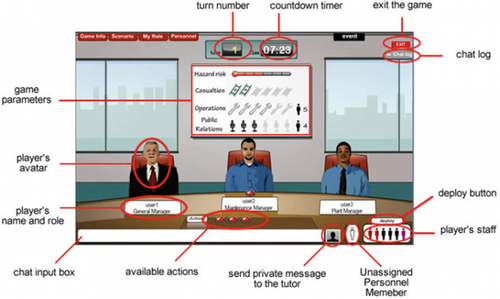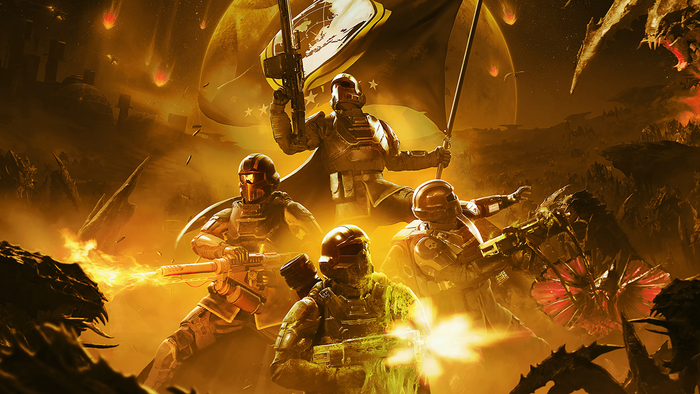Designing games to teach Soft Skills (Part 3/4- Examples)
How training methodologies can be adopted by a wide range of professionals and purposes to enhance traditional training practice, boost participants’ learning experience, heighten participants’ self-awareness and self-confidence and facilitate knowledge.

Designing Games to Teach Soft Skills and Learning Soft Skills by Playing Video Games
<---Part 2: Advantage in Game Based Learning
Part 3: Examples
Part 4: Personal Suggestions and Conclusion-->
3. Examples
3.1 DREAD-ED improving Communication Skills in critical situations
The game mechanics of DREAD-ED have been designed to force players to communicate and exchange information in the context of disaster management. Triggering team communication has been recognized as one of the most notable characteristics of DREAD-ED and has been ranked by participants at the top of the list of the skills needed in a group decision making context.

Fig 10. DREAD-ED game interface
Moreover, team communication was evaluated as crucial for effective group performance.
One aspect experienced during the game was the efficacy of a far-sighted strategy in some circumstances, in other words long-term thinking. In the trials, the players realized after a few game sessions that a more forward-looking strategy was necessary to prevent the effects of unpredictable events on the game parameters. This revealed the potential of the game in teaching long-term thinking and planning.
The teamwork style of each participant also played an important role in group performance. Being aware of one’s teamwork style has been identified as an important step towards a successful group decision-making process.
Multitasking was reported by players as a specific ability required in real-life working contexts. The DREAD-ED game design did not put particular emphasis on that, and the participants suggested it as a potential development in a new version of the game.
During the pilot test game sessions, some players adopted a rather autonomous behavior contrasting with the collaborative strategy adopted by the rest of the group. This raised a discussion about the right balance between the level of autonomy and cooperation.
Risk management is an interesting skill that can be improved by means of a serious game. Training in risk management can be very difficult in the real working setting because of the potential negative consequences and high cost associated with it. On the contrary, serious games and simulation can provide a safe context in which to assess and train risk management skills.
Decisiveness is another quality that can be safely practiced and improved in a game experience. Some negative consequences of not being decisive, both as an individual and as a group, can be learnt in the serious game context.
A key aspect of decision-making experienced during the pilot tests was the need for strong organizational skills. After a few game sessions, players realized that having a good organization allowed the group to react quickly to upcoming events.
One of the first things that started to become structured after a few game sessions was the communication pattern, given the importance in the game of quickly exchanging information about resources and roles.
By playing the game, each participant experimented an interesting way of achieving self-awareness. The multiplayer feature of the game, together with the fast paced interaction needed during the sessions, gave the players much feedback about their behavior during a short space of time. This is quite unusual in real-life situations where experiences and interactions are spread out over a longer period. This enhanced effect of short feedback loops highlighted the self-knowledge potential of this kind of multiplayer game.
3.2 Learn to Lead: An educational Game for leaders to be
3.2.1 Leadership Theory
Many definitions have been proposed about leadership: Chemers (1998) defines it as “a process of social influence in which a person can enlist the aid and support of others in the accomplishment of a common task”; Myers and Smith (2000) see it as a process thanks to which some people in a group mobilize or lead other group components to help them in reaching their objectives; Hollander (1985) underlines the aspect of influencing other people and assuming relevant roles in a hierarchy; Moscovici (1976) also introduces the theme of power, connecting it to influence.
Many approaches have also been adopted to deal with this theme. The first one is the behavioral one that considers leadership as a set of behaviors. Some research indicates that specific behaviors can predict one’s emergence as a leader, and these behaviors belong to two categories, task- and member-focused behavior (Bales 1950; Taggar et al. 1999; Bales and Slater 1955). Lewin, Lippitt and White (1939) recognize three leadership styles, democratic, authoritarian and laissez-faire, whereas Likert (1961) identifies two main leadership styles, job- centered and employee-centered.
The behavioral approach does not consider that even if some leadership traits and behaviors are commonly observed across a number of studies, a huge amount of evidence suggests that persons who are leaders in one situation may not necessarily be leaders in other situations. This idea has been adopted by Tannenbaum and Schmidt (1958) with the situational leadership continuum and Fiedler (1964) who proposes the contingency model. Tannenbaum and Schmidt sketch two dimensions to explain leadership patterns: boss-centered leadership and subordinate-centered leadership and underline that situational elements can orient style choice such as organizational culture and collaborators’ features.
3.2.2 Learn to Lead Game Description
Leadership is a key competence that can be acquired through adequate training which is crucial in every kind of organization. In SMEs, non-profit organizations and work groups (Yukl and Van Fleet 1992; Storey 2004), many training programs are devoted to teaching effective leadership.
What narrative does L2L (Learn to Lead) rely on? The player is hired to work in a large corporation. The CEO has picked the player out as a future leader and has arranged for her to follow a program of on-the-job training, where she will learn all that is necessary to become a great leader. The game is played across a number of levels. Across those levels, the player will lead teams in a number of different corporation departments, from catering to research and development.
During the game, the player has two goals:
Ensure that the company runs efficiently and productively.
Ensure that her followers develop appropriately, as outlined by the full-range leadership (FRL) model.
The third outcome of leadership, satisfaction of followers, has not been implemented, because this requires a value judgement, something that is not feasible yet in a game context.
With a smart management, it is possible to finish a respectable number of jobs within their deadlines. However, leadership involves more than management, and if the player uses a strategy for developing her followers, he/she will gain an effective advantage in the game. In fact, each follower has an ability level and a motivation level: these two variables combined define the amount of work the follower can do in any given day.
The player can consider her followers’ workloads, abilities, stress levels and personalities in assigning players to jobs, a typical management task, and this will improve performance with respect to a leader who limits herself to standard managing.
In this optic, the player has the option of running workshops, organizing teambuilding events, performing one-to-one coaching, getting involved in day-to-day work, sending memos, proposing training courses, giving lectures about poor performance, delivering evocative speeches at staff meetings, etc., thus helping her followers’ development in ability and intrinsic motivation. More developed followers can complete more jobs; thus spending time on developing staff helps the player to reach both efficiency and development, the goals that players should be aiming for, according to the FRL model.
Followers experience stress, which affects their ability to work. Stress can be caused by demanding more work of the follower than their level of ability allows and is also naturally increased by imminent deadlines. The work has also a competitive side: the player must compete with other groups to achieve goals: manage workloads, stress and employees’ motivations in order to increase profit, create new services and improve customer satisfaction. The system allows users to experiment different approaches before competing with other players. At the beginning of the game, the player is explicitly introduced in the narrative with a specific description of what the game will be like. The player has different learning chances during the game, and it is possible to follow tutor’s suggestions or study the provided materials besides playing the game. L2L is divided into 5 levels, which are increasingly complex and articulated.

Fig 11. Image from gameplay of Learn to Lead, level 5.
At the beginning of each level, reading material, tutorials and mini-games are provided about some theories and principles of leadership, such as path goal theory and full-range leadership. After the player has completed the theoretical part, he/she is able to practice it in a safe environment (the player is not fired if she fails), where the level of acquired knowledge is evaluated. In order to surpass a level, it is necessary to study leadership theory and apply it to the virtual environment as required by the game.
3.2.3 Learn to Lead Game Mechanics
Playing is based on a turn-based structure so that players always have an unlimited amount of time to consider their actions carefully and consult reference material about FRL if necessary before making a decision. The player acts on the work environment and team dynamics by setting the work plan of each follower.
There are three main types of interaction between the leader and the followers:
Stimulation: the leader stimulates a follower, by talking to her or in some other way.
Punishment: the leader gives a punishment to a follower.
Reward: the leader gives a reward to a follower.
Leader choices influence the psychology of followers, in particular their motivation, and thus their contribution to the team. These are the moves that change the problem state. The player interacts with followers and artificial agents with their own psychological state that the player has to monitor carefully if she wants to advance successfully in the game.
The psychology of followers (artificial) is composed of three variables taken from the cited McClelland theory [4]:
Achievement: followers have a disposition for excellence in performance, a continuing concern for doing better all the time. This motive concerns achieving excellence through one’s individual efforts.
Affiliation: followers have a concern for establishing, maintaining and restoring close personal relationships with others.
Power: followers have a concern for acquiring status and having an impact on others. High power motivation induces highly competitive behavior.
It is important to stress that followers with different personalities should be managed in a different way to obtain optimal results. Each follower is represented by an animated character sitting at the desk and typing in front of a computer. The character is animated and conveys important information about followers’ internal states. Typing speed is proportional to follower motivation and the face changes from normal to stressed when the stress level approaches a dangerous level. Each follower has to accomplish a task allocated by the leader, in different kinds of environments. The maximum workload is determined by two variables: ability and motivation. The player/leader can vary those variables through a series of possible actions (e.g. by sending the follower to a training course or by stressing them). Leaders obtain a score on the basis of the motivational and skill development of the followers. The team spends 30 days in accomplishing a task, and each day a measure of outcome is computed, based on each follower. Each day the leader can make just one action with respect to a selected follower. At the end of the specified time lapse, the final work outcome is computed and a leadership profile is created.
During the game, because many important aspects of player leadership are involved, at the end of each level or tutorial, a summary of these aspects is proposed. In more detail, the following information is shown:
Workload management: shows how the followers are busy doing their work; this affects stress level.
Followers’ stress.
Followers’ motivation.
Leadership style: gives the player feedback about the style used when performing a leadership task—transactional, transformational or mixed.
Ability management: shows how the player took into account follower ability when performing leadership tasks.
Personality management: shows how the player took into account follower personality when performing leadership tasks.
Conflict management: shows how the player took into account follower personality to avoid conflicts in the team while assigning jobs to members.

Fig 12. L2L Game model. According to FRL theory, each agent’s behavior is guided by a set of external variables such as leader’s behavior, workload, etc., and a set of internal variables related to personality, motivation, ability and stress. The agent model in L2L has been implemented exploiting neural nets
3.3 Role Playing Games
It is widely recognized that role play [8] is particularly suited to experiential leaning. It is a powerful tool that enables participants to draw into an experience and move the learning experience from an impersonal, theoretical and notional form into interactive and participative dimensions.
Regardless of the field and discipline of application, we believe that role-play technique does not simply enhance experiential learning. Role play uses the art form of dramatization onto an educational stage, enabling learners to increase awareness of self and others, enhance mental flexibility and imagination, enlarge personal perspectives and create multiple perspectives and extend thoughts and feelings beyond the horizon of personal interpretation. Role enactment nurtures both cognitive and emotional skills and capabilities that can open up new solutions and opportunities for actions, and helps to identify and face a new level of reality and interpretation of the surrounding environment, both in relation to ourselves and in the interaction with others (Boggs et al. 2007).
Psychodrama, socio-drama and simulation settings can be seen as different implementations of role play, which according to different purposes have been exploited in psychotherapy, education, counselling, personal development, business and organizational and training contexts. Role play has extensively been recognized as a powerful technique for enhancing the traditional training practice, boosting participants’ learning experience, facilitating knowledge and promoting skills, competencies and group, as well as personal development, in face-to-face activities (e.g. McGill and Beaty 2001; Shaw et al. 1980; Turner 1992; Van Ments 1999).
Two fundamental characteristics of role play emerged from this discussion: one is related to the role of the director who can be referred to as the therapist, educator, trainer, coach, consultant or psychologist (within a specific setting, he/she defines scenarios to be performed, harmonizing roles to be explored, feedback and debriefing processes with layers, as well as group needs); and the other is that role play implies a level of personal growth through experiences that is possible, thanks to the presence of a group.
3.4 Digital environment
As highlighted earlier, because of their experiential and behavioral nature, soft skills cannot be effectively imparted and accomplished with traditional pedagogical approaches. For meaningful transfer of relevant skills and behaviors to real-life and working contexts, a pedagogical shift to participating-active methods is needed [5].
Literature has already highlighted the increased interest around online games as a medium for learning and demonstrates how these could be adopted within education and training contexts (Squire 2003; Egenfeldt-Nielsen 2005; Michael and Chen 2005a, b; de Freitas and Oliver 2006).
There is another term discussed in the book: EMORPG (Educational Multiplayer Online Role Playing Game). Educational denotes both characteristics and purpose of the play; multiplayer [10] refers to the fact that learners play simultaneously in the same online world; online specifies that the game to be played requires an Internet connection; role-playing games [8] indicates that when players join the virtual environment, they interact with each other through controlling a digital alter ego (an avatar) with physical appearance and personality aspects that can be more or less related to the real player interpreting it.
EMORPG provides a structure, a design of the narrative experience, processes of feedback, reflection and self-awareness, ensuring occurrence and transference of learning, as the simulation scenario is designed and implemented in line with identified pedagogical objectives and taking into account group training needs.
<---Part 2: Advantage in Game Based Learning
Part 3: Examples
Part 4: Personal Suggestions and Conclusion-->
References
[1] Dell'Aquila, Elena, Davide Marocco, Michela Ponticorvo, Andrea Di Ferdinando, Massimiliano Schembri, and Orazio Miglino. Educational Games for Soft-skills Training in Digital Environments: New Perspectives. Switzerland: Springer, 2017.
[4] Need theory. (2017, March 15). In Wikipedia, The Free Encyclopedia. Retrieved 19:15, June 21, 2017, from https://en.wikipedia.org/w/index.php?title=Need_theory
[5] Digital environment. (2017, April 20). In Wikipedia, The Free Encyclopedia. Retrieved 19:17, June 21, 2017, from https://en.wikipedia.org/w/index.php?title=Digital_environment
[8] Role-playing game. (2017, June 16). In Wikipedia, The Free Encyclopedia. Retrieved 19:28, June 21, 2017, from https://en.wikipedia.org/w/index.php?title=Role-playing_game
[10] Massively multiplayer online role-playing game. (2017, June 14). In Wikipedia, The Free Encyclopedia. Retrieved 19:35, June 21, 2017, from https://en.wikipedia.org/w/index.php?title=Massively_multiplayer_online_role-playing_game
Read more about:
BlogsAbout the Author(s)
You May Also Like













